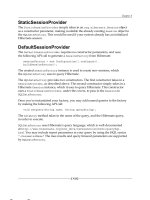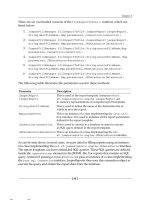Leanpub learn scala for java developers
Bạn đang xem bản rút gọn của tài liệu. Xem và tải ngay bản đầy đủ của tài liệu tại đây (2.86 MB, 159 trang )
LearnScalaforJavaDevelopers
TobyWeston
Thisbookisforsaleat />Thisversionwaspublishedon2015-04-21
*****
ThisisaLeanpubbook.LeanpubempowersauthorsandpublisherswiththeLean
Publishingprocess.LeanPublishingistheactofpublishinganin-progressebookusing
lightweighttoolsandmanyiterationstogetreaderfeedback,pivotuntilyouhavetheright
bookandbuildtractiononceyoudo.
*****
©2015TobyWeston
TableofContents
Preface
I.ScalaTour
TheScalaLanguage
PureFunctions
Higher-OrderFunctions
Scala’sBackground
TheFuture
InstallingScala
TheScalaInterpreter
ScalaScripts
scalac
SomeBasicSyntax
DefiningValuesandVariables
DefiningFunctions
OperatorOverloadingandInfixNotation
Collections
JavaInteroperability
PrimitiveTypes
Scala’sClassHierarchy
AnyVal
Unit
AnyRef
BottomTypes
ScalaDoc
LanguageFeatures
WorkingwithSourceCode
WorkingwithMethods
FunctionalProgramming
Summary
II.KeySyntacticalDifferences
ClassesandFields
CreatingClasses
DerivedSettersandGetters
RedefiningSettersandGetters
Summary
ClassesandObjects
ClassesWithoutConstructorArguments
AdditionalConstructors
SingletonObjects
CompanionObjects
Inheritance
SubtypeInheritance
AnonymousClasses
Interfaces/Traits
AbstractClasses
Polymorphism
DecidingBetweentheOptions
ControlStructures
Conditionals
LoopingStructures;do,whileandfor
BreakingControlFlow(breakandcontinue)
Exceptions
Generics
ParametricPolymorphism
BoundedClasses
Variance
III.BeyondJavatoScala
FakingFunctionCalls
TheapplyMethod
TheupdateMethod
Summary
FakingLanguageConstructs
CurlyBraces(andFunctionLiterals)
Currying
Summary
PatternMatching
Switching
Patterns
LiteralMatches
ConstructorMatches
TypeQuery
DeconstructionMatchesandunapply
GuardConditions
MapandFlatMap
MappingFunctions
FlatMap
NotJustforCollections
Monads
BasicDefinition
Option
MoreFormalDefinition
Summary
ForComprehensions
WhereWeLeftOff
UsingNullChecks
UsingflatMapwithOption
HowForComprehensionsWork
Finally,UsingaForComprehensionforShippingLabels
Summary
IV.AdoptingScalainJavaTeams
AdoptingScala
AvoidNotEnough
Don’tDoTooMuch
PurelyFunctionalFTW?
WhattoExpect
TheLearningCurve
TheLearningContinuum
Tips
BeClear
GetGuidance
HaveaPlan
ConvertYourCodebase
ManageYourCodebase
Conventions
WhattoAvoid
OtherChallenges
SyntaxCheatSheet
Index
Preface
Audience
ThisbookisforJavadeveloperslookingtotransitiontoprogramminginScala.
AbouttheAuthor
TobyWestonisanindependentsoftwaredeveloperbasedinLondon.Hespecialisesin
JavaandScaladevelopment,workinginagileenvironments.He’sakeenbloggerand
writer,havingwrittenforJAXenterandauthoredthebooksEssentialAcceptanceTesting
andWhat’sNewinJava8.Abigsupporterofopensourcesoftware,Tobyhascontributed
toseveralprojectsincludingjMock.
TheStructureoftheBook
Thebookissplitintofourparts:atourofScala,acomparisonbetweenJavaandScala,
Scala-specificfeaturesandfunctionalprogrammingidioms,andfinallyadiscussionabout
adoptingScalaintoexistingJavateams.
Inthefirstpart,we’regoingtotakeahigh-leveltourofScala.You’llgetafeelforthe
language’sconstructsandhowScalaissimilarinalotofwaystoJava,yetverydifferent
inothers.We’lltakealookatinstallingScalaandusingtheinteractiveinterpreterand
we’llgothroughsomebasicsyntaxexamples.
PartII.talksaboutkeydifferencesbetweenJavaandScala.We’lllookatwhat’smissing
inScalacomparedtoJavaandhowconceptstranslatefromonelanguagetoanother.
TheninPartIII.,we’lltalkaboutsomeofthelanguagefeaturesthatScalaoffersthat
aren’tfoundinJava.Thissectionalsotalksalittleaboutfunctionalprogrammingidioms.
Finally,we’lltalkaboutadoptingScalaintolegacyJavaprojectsandteams.It’snot
alwaysaneasytransition,sowe’lllookatwhyyouwouldwantto,andsomeofthe
challengesyoumightface.
Credits
AuthorTobyWeston()
CopyeditorAmyBrown()
I.SCALATOUR
WelcometoLearnScalaforJavaDevelopers.Thisbookwillhelpyoutransitionfrom
programminginJavatoprogramminginScala.It’sdesignedtohelpJavadevelopersget
startedwithScalawithoutnecessarilyadoptingallofthemoreadvancedfunctional
programmingidioms.
Scalaisbothanobject-orientedlanguageandafunctionallanguageandalthoughIdotalk
aboutsomeoftheadvantagesoffunctionalprogramming,thisbookismoreaboutbeing
productivewithimperativeScalathangettingtogripswithfunctionalprogramming.If
you’realreadyfamiliarwithScalabutarelookingtomaketheleaptopurefunctional
programming,thisprobablyisn’tthebookforyou.CheckouttheexcellentFunctional
ProgramminginScalabyPaulChiusanoandRúnarBjarnasoinstead.
Thebookoftencompares“like-for-like”betweenJavaandScala.So,ifyou’refamiliar
withdoingsomethingaparticularwayinJava,I’llshowhowyoumightdothesamething
inScala.Alongtheway,I’llintroducetheScalalanguagesyntax.
TheScalaLanguage
Scalaisbothafunctionalprogramminglanguageandanobject-orientedprogramming
language.AsaJavaprogrammer,you’llbecomfortablewiththeobject-oriented
definition:Scalahasclasses,objects,inheritance,composition,polymorphism—allthe
thingsyou’reusedtoinJava.
Infact,ScalagoessomewhatfurtherthanJava.Thereareno“non”-objects.Everythingis
anobject,sotherearenoprimitivetypeslikeintandnostaticmethodsorfields.
Functionsareobjectsandevenvaluesareobjects.
Scalacanbeaccuratelydescribedasafunctionalprogramminglanguagebecauseitmeets
somefairlyformalcriteria.Forexample,itallowsyoubothtodefinepurefunctionsand
usehigher-orderfunctions.
PureFunctions
Purefunctionsaren’tassociatedwithobjects,andworkwithoutsideeffects.Akey
concerninScalaprogrammingisavoidingmutation.There’sevenakeywordtodefinea
fixedvariable,alittlelikeJava’sfinal:val.
Purefunctionsshouldoperatebytransformationratherthanmutation.Thatistosay,a
purefunctionshouldtakeargumentsandreturnresultsbutnotmodifytheenvironmentit
operatesin.Thispurityoffunctioniswhatenablesreferentialtransparency.
Higher-OrderFunctions
Functionallanguagesshouldtreatfunctionsasfirst-classcitizens.Thismeanstheysupport
higher-orderfunctions:functionsthattakefunctionsasargumentsorreturnfunctionsand
allowfunctionstobestoredforlaterexecution.Thisisapowerfultechniqueinfunctional
programming.
Scala’sBackground
Scalastartedlifein2003asaresearchprojectatEPFLinSwitzerland.Theprojectwas
headedbyMartinOdersky,who’dpreviouslyworkedonJavagenericsandtheJava
compilerforSunMicrosystems.
It’squiterareforanacademiclanguagetocrossoverintoindustry,butOderskyandothers
launchedTypesafeInc.,acommercialenterprisebuiltaroundScala.Sincethen,Scalahas
movedintothemainstreamasadevelopmentlanguage.
ScalaoffersamoreconcisesyntaxthanJavabutrunsontheJVM.RunningontheJVM
should(intheory)meananeasymigrationtoproductionenvironments;ifyoualready
havetheOracleJVMinstalledinyourproductionenvironment,itmakesnodifferenceif
thebytecodewasgeneratedfromtheJavaorScalacompiler.
ItalsomeansthatScalahasJavainteroperabilitybuiltin,whichinturnmeansthatScala
canuseanyJavalibrary.OneofJava’sstrengthsoveritscompetitorswasalwaysthehuge
numberofopensourcelibrariesandtoolsavailable.Theseareprettymuchallavailableto
Scalatoo.TheScalacommunityhasthatsameopensourcementality,andsothere’sa
growingnumberofexcellentScalalibrariesoutthere.
TheFuture
Scalahasdefinitelymovedintothemainstreamasapopularlanguage.Ithasbeenadopted
bylotsofbigcompaniesincludingTwitter,eBay,Yahoo,HSBC,UBS,andMorgan
Stanley,andit’sunlikelytofalloutoffavouranytimesoon.Ifyou’renervousaboutusing
itinproduction,don’tbe;it’sbackedbyaninternationalorganisationandregularlyscores
wellinpopularityindexes.
ThetoolingisstillbehindJavathough.PowerfulIDEslikeIntelliJ’sIDEAandEclipse
makerefactoringJavacodestraightforwardbutaren’tquitethereyetforScala.Thesame
istrueofcompiletimes:ScalaisalotslowertocompilethanJava.Thesethingswill
improveovertime,andonbalance,they’renotthebiggesthindrancesIencounterwhen
developing.
InstallingScala
ThereareacoupleofwaystogetstartedwithScala.
1. YoucanrunScalainteractivelywiththeinterpreter,
2. runshorterprogramsasshellscripts,or
3. compileprogramswiththescalaccompiler.
TheScalaInterpreter
BeforeworkingwithanIDE,it’sprobablyworthgettingfamiliarwiththeScala
interpreter,orREPL.
DownloadthelatestScalabinaries(fromandextractthe
archive.AssumingyouhaveJavainstalled,youcanstartusingtheinterpreterfroma
commandpromptorterminalwindowstraightaway.Tostartuptheinterpreter,navigateto
theexplodedfolderandtype1:
bin/scala
You’llbefacedwiththeScalaprompt.
scala>_
Youcantypecommandsfollowedbyenter,andtheinterpreterwillevaluatethe
expressionandprinttheresult.Itreads,evaluatesandprintsinaloopsoit’sknownasa
REPL.
Ifyoutype42*4andhitenter,theREPLevaluatestheinputanddisplaystheresult.
scala>42*4
res0:Int=168
Inthiscase,theresultisassignedtoavariablecalledres0.Youcangoontousethis,for
exampletogethalfofres0.
scala>res0/2
res1:Int=84
Thenewresultisassignedtores1.
NoticetheREPLalsodisplaysthetypeoftheresult:res0andres1arebothintegers
(Int).Scalahasinferredthetypesbasedonthevalues.
Ifyouaddres1totheendofastring,noproblem;thenewresultobjectisastring.
scala>"HelloPrisoner"+res1
res2:String=HelloPrisoner84
ToquittheREPL,type:
:quit
ScalaScripts
ThecreatorsofScalaoriginallytriedtopromotetheuseofScalafromUnixshellscripts.
AscompetitiontoPerl,GroovyorbashscriptsonUnixenvironmentsitdidn’treallytake
off,butifyouwantto,youcancreateashellscripttowrapScala:
1#!/bin/sh
2execscala"$0""$@"
3!#
4objectHelloWorld{
5defmain(args:Array[String]){
6println("Hello,"+args.toList)
7}
8}
9HelloWorld.main(args)
Don’tworryaboutthesyntaxorwhatthescriptdoes(althoughI’msureyou’vegota
prettygoodideaalready).TheimportantthingtonoteisthatsomeScalacodehasbeen
embeddedinashellscriptandthatthelastlineisthecommandtorun.
You’dsaveitasa.shfile,forexamplehello.sh,andexecuteitlikethis:
./hello.shWorld!
Theexeccommandonline2spawnsaprocesstocallscalawitharguments;thefirstis
thescriptfilenameitself(hello.sh)andthesecondistheargumentstopasstothescript.
ThewholethingisequivalenttorunningScalalikethis,passinginashellscriptasan
argument:
scalahello.shWorld!
scalac
Ifyou’dprefer,youcancompile.scalafilesusingtheScalacompiler.
Thescalaccompilerworksjustlikejavac.ItproducesJavabytecodethatcanbe
executeddirectlyontheJVM.Yourunthegeneratedbytecodewiththescalacommand.
JustlikeJavathough,it’sunlikelyyou’llwanttobuildyourapplicationsfromthe
commandline.
AllthemajorIDEssupportScalaprojects,soyou’remorelikelytocontinueusingyour
favoriteIDE.We’renotgoingtogointothedetailsofhowtosetupaScalaprojectineach
ofthemajorIDEs;ifyou’refamiliarwithcreatingJavaprojectsinyourIDE,theprocess
willbeverysimilar.
Forreferencethough,hereareafewstartingpoints.
YoucancreatebootstrapprojectswithMavenandthemaven-scala-plugin.
YoucancreateanewScalaprojectdirectlywithinIntelliJIDEAonceyou’ve
installedthescalaplugin(availableintheJetBrainsrepository).
Similarly,youcancreateanewScalaprojectdirectlywithinEclipseonceyouhave
theScalaIDEplugin.Typesafecreatedthisandit’savailablefromtheusualupdate
sites.Youcanalsodownloadabundledirectlyfromthescala-langorscala-ide.org
sites.
YoucanuseSBTandcreateabuildfiletocompileandrunyourproject.SBTstands
forSimpleBuildToolandit’sakintoAntorMaven,butfortheScalaworld.
SBTalsohaspluginsforEclipseandIDEA,soyoucanuseitdirectlyfromwithinthe
IDEtocreateandmanagetheIDEprojectfiles.
1. Ifyoudon’twanttochangeintotheinstallfoldertoruntheREPL,setthebinfolder
onyourpath.↩
SomeBasicSyntax
DefiningValuesandVariables
Let’slookatsomesyntax.We’llstartbycreatingavariable:
vallanguage:String="Scala";
We’vedefinedavariableasaStringandassignedtoitthevalueof“Scala”.Isay
“variable”,butwe’veactuallycreatedanimmutablevalueratherthanavariable.Theval
keywordcreatesaconstant,andlanguagecannotbemodifiedfromthispointon.
Immutabilityisakeythemeyou’llseeagainandagaininScala.
Ifwewillwanttomodifylanguagelater,wecanusevarinsteadofval.Wecanthen
reassignitifweneedto.
varlanguage:String="Java";
language="Scala";
Sofar,thisdoesn’tlookverydifferentfromJava.Inthevariabledefinition,thetypeand
variablenamearetheoppositewayroundcomparedtoJava,butthat’saboutit.However,
Scalausestypeinferenceheavily,soScalaknowsthatthevaraboveisastring,evenifwe
don’ttellit.
vallanguage="Scala";
Similarly,itknowsthattheexpressionisfinishedwithoutneedingtotellitexplicitlywith
thesemicolon.Sowecandropthattoo.
vallanguage="Scala"//nosemicolon
Youonlyneedtoaddsemicolonswhenyouusemultipleexpressionsonthesameline;
otherwisethingsgettoocomplexforthecompiler.
Operatorprecedenceisjustasyou’dexpectinJava.Intheexamplebelow,the
multiplicationhappensbeforethesubtraction.
scala>valage=35
scala>varmaxHeartRate=210-age*.5
res0:Double=191.5
DefiningFunctions
Functionandmethoddefinitionsstartwiththedefkeyword,followedbythesignature.
ThesignaturelookssimilartoaJavamethodsignaturebutwiththeparametertypesthe
otherwayroundagain,andthereturntypeattheendratherthanthestart.
Let’screateafunctiontoreturntheminimumoftwonumbers.
defmin(x:Int,y:Int):Int={
if(x
else
returny
}
WecantestitintheREPLbycallingit:
scala>min(34,3)
res3:Int=3
scala>min(10,50)
res4:Int=10
NotethatScalacan’tinferthetypesoffunctionarguments.
Anothertrickisthatyoucandropthereturnstatement.Thelaststatementinafunction
willimplicitlybethereturnvalue.
defmin(x:Int,y:Int):Int={
if(x
else
y
}
RunningittheREPLwouldshowthefollowing:
scala>min(300,43)
res5:Int=43
Inthisexample,theelsemeansthelaststatementisconsistentwithaminfunction.IfI
forgottheelse,thelaststatementwouldbethesameregardlessandtherewouldbeabug
inourimplementation:
defmin(x:Int,y:Int):Int={
if(x
y//bug!where'stheelse?
}
Italwaysreturnsy:
scala>min(10,230)
res6:Int=230
Ifyoudon’tuseanyreturnstatements,thereturntypecanusuallybeinferred.
//thereturntypecanbeomitted
defmin(x:Int,y:Int)={
if(x
else
y
}
Notethatit’stheequalssignthatsaysthisfunctionreturnssomething.IfIwritethis
functionononeline,withoutthereturntypeandjusttheequalssign,itstartstolooklikea
realexpressionratherthanafunction.
defmin(x:Int,y:Int)=if(x
Bewary,though;ifyouaccidentallydroptheequalssign,thefunctionwon’treturn
anything.It’llbesimilartothevoidinJava.
defmin(x:Int,y:Int){
if(x
}
<console>:8:warning:apureexpressiondoesnothinginstatementposition;
youmaybeomittingnecessaryparentheses
if(x
<console>:8:warning:apureexpressiondoesnothinginstatementposition;
youmaybeomittingnecessaryparentheses
if(x
min:(x:Int,y:Int)Unit
Althoughthiscompilesokay,thecompilerwarnsthatyoumayhavemissedofftheequals
sign.
OperatorOverloadingandInfixNotation
OneinterestingthingtonoteinScalaisthatyoucanoverrideoperators.Arithmetic
operatorsare,infact,justmethodsinScala.Assuch,youcancreateyourown.Earlier,we
sawtheintegerageusedwithamultiplier.
valage:Int
age*.5
Thevalueageisanintegerandthereisamethodcalled*ontheintegerclass.Ithasthe
followingsignature:
def*(x:Double):Double
NumbersareobjectsinScala,asareliterals.Soyoucancall*directlyonavariableora
number.
age.*(.5)
5.*(10)
Usingtheinfixnotation,you’reabletodropthedotnotationforvariablesandliteralsand
call:
age*.5
or,asanotherexample:
35toString
Remember,35isaninstanceofInt.
Specifically,Scalasupportforinfixnotationmeansthatwhenamethodtakeszeroorone
argumentsyoucandropthedotandparentheses,andifthereismorethanoneargument
youcandropthedot.
Forexample:
35+10
"aBCDEFG"replace("a","A")
It’soptionalthough;youcanusethedotnotationifyouprefer.
Whatthismeansisthatyoucandefineyourownplusorminusmethodonyourown
classesanduseitnaturallywithinfixnotation.Forexample,youmighthaveaPassenger
joinaTrain.
train+passenger
Therearenotmanyrestrictionsonwhatyoucancallyourfunctionsandmethods;youcan
useanysymbolthatmakessensetoyourdomain.
Collections
Scalacomeswithitsownimmutablecollectiontypesaswellasmutableversions.By
defaultimmutabilityispreferred,sowecancreatealistwiththefollowing:
vallist=List("a","b","c")
Andcreateamapwith:
valmap=Map(1->"a",2->"b")
wherethearrowgoesfromthekeytothevalue.Thesewillbeimmutable;youwon’tbe
abletoaddorremoveelements.
YoucanprocesstheminasimilarwaytoJava8’sforEachandlambdasyntax:
list.foreach(value=>println(value))//scala
whichisequivalenttothefollowinginJava:
list.forEach(value->System.out.println(value));//java
LikeJava8’smethodreferencesyntax,youcanauto-connectthelambdaargumenttothe
methodcall.
list.foreach(println)//scala
whichisroughlyequivalenttothisJava:
list.forEach(System.out::println);//java
TherearelotsofotherScala-esquewaystoprocesscollections.We’lllookattheselater,
butthemostcommonwaytoiterateisaforloopwrittenlikethis:
for(value<-list)println(value)
whichreads,“foreveryvalueinlist,printthevalue”.Youcanalsodoitinreverse:
for(value<-list.reverse)println(value)
oryoumightliketobreakitacrossmultiplelines:
for(value<-list){
println(value)
}
JavaInteroperability
ImentionedthatyoucanuseanyJavaclassfromScala.Forexample,let’ssaywewantto
createaJavaListratherthantheusualScalaimmutableList.
vallist=newjava.util.ArrayList[String]
Allwedidwasfullyqualifytheclassname(java.util.ArrayList)andusenewto
instantiateit.Noticethesquarebrackets?Scaladenotesgenericsusing[]ratherthan<>.
Wealsodidn’thavetousetheparenthesesontheconstructor,aswehadnoargumentsto
passin.
Wecanmakemethodcalls—forexample,addinganelement—justasyou’dexpect:
list.add("Hello")
or,usinginfix:
listadd"World!"
PrimitiveTypes
InJavatherearetwointegertypes:theprimitive(non-object)intandtheIntegerclass.
Scalahasnoconceptofprimitives—everythingisanobject—so,forexample,Scala’s
integertypeisanInt.Similarly,you’llbefamiliarwiththeotherbasictypes:
Byte
Short
Int
Long
Char
String
Float
Double
Boolean
AlthoughScalahasitsownrichertypes,typicallytheyjustwraptheJavatypes.When
workingwiththesebasictypes,ninetimesoutoftenyouwon’tneedtoworryifyou’re
usingScalaorJavatypes.Thingsareprettyseamless.Forexample,Scalahasa
BigDecimaltypewitha+methodwhichmeansyoucanaddtwobigdecimalswithmuch
lesscodethaninJava.
ComparethefollowingScalatoJava:
//scala
valtotal=BigDecimal(10000)+BigDecimal(200)
//java
BigDecimaltotal=newBigDecimal(10000).add(newBigDecimal(200));
Scalahasn’treimplementedJava’sBigDecimal;itjustdelegatestoitandsavesyouhaving
totypeallthatboilerplate.
Scala’sClassHierarchy
Scala’sclasshierarchystartswiththeAnyclassinthescalapackage.Itcontainsmethods
like==,!=,equals,##,hashCode,andtoString.
abstractclassAny{
finaldef==(that:Any):Boolean
finaldef!=(that:Any):Boolean
defequals(that:Any):Boolean
def##:Int
defhashCode:Int
deftoString:String
//...
}
EveryclassinScalainheritsfromtheabstractclassAny.Ithastwoimmediatesubclasses,
AnyValandAnyRef.
Fig.1.1.EveryclassextendstheAnyclass.
AnyVal
AnyValisthesuper-typetoallvaluetypes,andAnyRefthesuper-typeofallreference
types.
BasictypessuchasByte,Int,Char,etc.areknownasvaluetypes.InJavavaluetypes
correspondtotheprimitivetypes,butinScalatheyareobjects.Valuetypesareall
predefinedandcanbereferredtobyliterals.Theyareusuallyallocatedonthestackbut
areallocatedontheheapinScala.
AllothertypesinScalaareknownasreferencetypes.Referencetypesareobjectsin
memory(theheap),asopposedtopointertypesinC-likelanguages,whichareaddresses
inmemorythatpointtosomethingusefulandneedtobedereferencedusingspecialsyntax
(forexample,*age=64inC).Referenceobjectsareeffectivelydereferenced
automatically.
ThereareninevaluetypesinScala:
Fig.1.2.Scala’svaluetypes.
Theseclassesarefairlystraightforward;theymostlywrapanunderlyingJavatypeand
provideimplementationsforthe==methodthatareconsistentwithJava’sequalsmethod.
Thismeans,forexample,thatyoucancomparetwonumberobjectsusing==andgeta
sensibleresult,eventhoughtheymaybedistinctinstances.
So,42==42inScalaisequivalenttocreatingtwoIntegerobjectsinJavaand
comparingthemwiththeequalsmethod:newInteger(42).equals(newInteger(42)).
You’renotcomparingobjectreferences,likeinJavawith==,butnaturalequality.
Rememberthat42inScalaisaninstanceofIntwhichinturndelegatestoInteger.
Unit
TheUnitvaluetypeisaspecialtypeusedinScalatorepresentanuninterestingresult.It’s
similartoJava’sVoidobjectorvoidkeywordwhenusedasareturntype.Ithasonlyone
value,whichiswrittenasanemptypairofbrackets:
scala>valexample:Unit=()
example:Unit=()
AJavaclassimplementingCallablewithaVoidobjectasareturnwouldlooklikethis:
//java
publicclassDoNothingimplementsCallable<Void>{
@Override
publicVoidcall()throwsException{
returnnull;
}
}
ItisidenticaltothisScalaclassreturningUnit:
//scala
classDoNothingextendsCallable[Unit]{
defcall:Unit=()
}
RememberthatthelastlineofaScalamethodisthereturnvalue,and()representsthe
oneandonlyvalueofUnit.
AnyRef
AnyRefisanactuallyanaliasforJava’sjava.lang.Objectclass.Thetwoare
interchangeable.ItsuppliesdefaultimplementationsfortoString,equalsandhashcode
forallreferencetypes.
ThereusedtobeasubclassofAnyRefcalledScalaObjectthatallScalareferencetypes
extended.However,itwasonlythereforoptimisationpurposesandhasbeenremovedin
Scala2.11.(Imentionitasalotofdocumentationstillreferstoit.)
Fig.1.3.ScalaAny.TheScalaObjectclassnolongerexists.
TheJavaStringclassandotherJavaclassesusedfromScalaallextendAnyRef.
(Rememberit’sasynonymforjava.lang.Object.)AnyScala-specificclasses,like
Scala’simplementationofalist,scala.List,alsoextendAnyRef.
Fig.1.4.Scala’sreferencetypes.
Forreferencetypeslikethese,==willdelegatetotheequalsmethodlikebefore.ForpreexistingclasseslikeString,equalsisalreadyoverriddentoprovideanaturalnotionof
equality.Foryourownclasses,youcanoverridetheequalsjustasyouwouldinJava,but
stillbeabletouse==incode.
Forexample,youcancomparetwostringsusing==inScalaanditwouldbehavejustasit
wouldinJavaifyouusedtheequalsmethod:
newString("A")==newString("A")//trueinscala,falseinjava
newString("B").equals(newString("B"))//trueinscalaandjava









